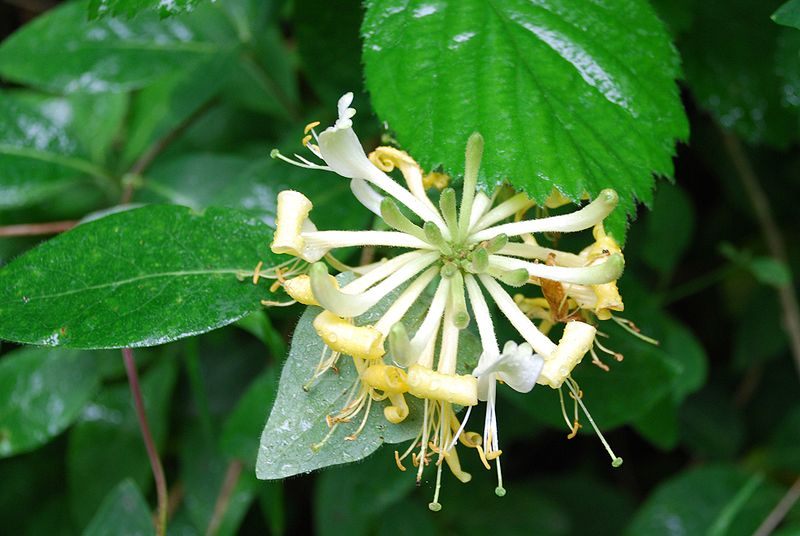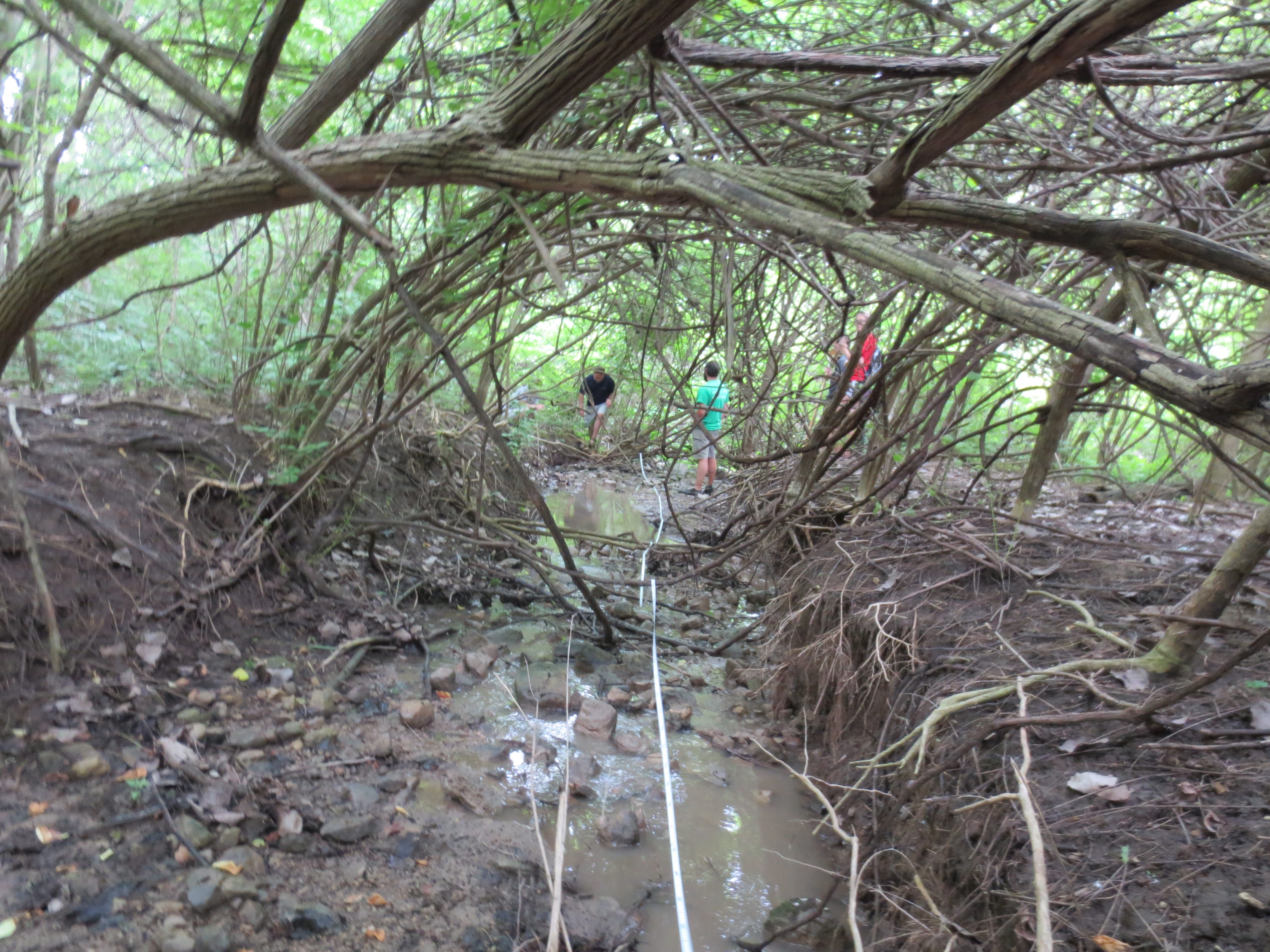Honeysuckle Is a Blob-Like Monster Taking Over American Forests
Honeysuckle is so invasive that some states have banned its sale.

Amur honeysuckle blossoms. (Photo: Ryan McEwan)
One of the signs of summer, for me, has always been tasting honeysuckle flowers. When I was a kid, they edged the yard of a family friend, and we’d stand there for ages, pulling out drops of nectar to touch against our tongue. As an adult, I spot their white and yellow flowers on the sides of the road or on city fences—they’re everywhere, it seems.
That’s not a good thing, though.
In recent years, New York banned honeysuckle bushes. So did Texas, and Massachusetts and New Hampshire. In those states, you’re not allowed to sell or buy honeysuckle. You’re not supposed to plant it in your yard, no matter how nice you think it looks or how convenient a hedge it would make. As a group, Asian honeysuckles are “perhaps the most widespread exotic invasives in the U.S.,” according to the Virginia Cooperative Extension—they can be found from New England, down to the Gulf, and west to the Ozark Mountains. It belongs to the pantheon of plants that grow so fast it can be frightening—kudzu, bamboo, mile-a-minute weed—and have had nothing stopping them. Even laws that ban the sale of these plants can only slow their spread. Once they’ve established their domains, they dig in and don’t let go.
“In some places, it’s creating a monoculture,” says Ryan McEwan, an ecologist at the University of Dayton, who studies these plants. In these forests, you can be encircled by honeysuckle, a veritable “wall of honeysuckle around you.” The plant can grow so dense, you have to crawl under it.
Honeysuckle might seem sweet, but it’s becoming a shape-shifting mega-villain that’s able to outcompete average plants, in its bid to try to take over the forest.

Amur honeysuckle takes over the shrub layer and holds its leaves long after the rest of the forest. (Photo: Ryan McEwan)
Honeysuckle comes in two forms, bush and vine, and there are native species of both in America. The honeysuckle species that have become problem plants—Amur honeysuckle, Morrow’s honeysuckle, Japanese honeysuckle, Tatarian honeysuckle, with its dark pink flowers—came from Asia, often via Europe, more than a century ago.
Amur honeysuckle, which has dark green leaves and garnet red berries, was first cultivated outside its native range by a German botanist working in a St. Petersburg’s imperial garden. Near the end of the 19th century, the St. Petersburg Garden sent seeds to Boston’s Arnold Arboretum and to the New York Botanical Garden.

Looks so innocent. (Photo: Michelle.Salter/CC BY-SA 3.0)
There was no reason to think the plant might spread wildly: it’s rare enough in its native range that it’s currently listed as endangered in Japan. In Europe, it’s never been a problem. But in America, the stuff went wild. As early as the 1920s, the Morton Arboretum in Chicago noted “its tendency to spread beyond the point of initial planting,” write James Luken and John Thieret in their account of Amur’s “fall from grace.” By the 1950s, there were reports of honeysuckle populations that were neither planted nor cared for by humans. By the end of the century, there were places it had taken over.
In Kentucky, where McEwan grew up, forests can be covered with honeysuckle. As a forest ecologist, he had been to old-growth forests where, standing on top of the slope, he could look far through the trees ahead. In a forest invaded by honeysuckle, the shrub layer of the forest can be too dense to walk through. Over streams, the honeysuckle creates a cave of branches. “You’re standing in the stream, and you feel like you’re in a tunnel,” McEwan says. He wanted to understand how honeysuckle was able to take over so dramatically.

The honeysuckle grows into a tunnel over the stream. (Photo: Ryan McEwan)
What makes a species invasive isn’t clear cut. There’s a federal list of “noxious weeds,” but states decide independently how to regulate undesirable plants. “Any species that is initially rare and then shows explosive growth, dominating the area, I’d call that an invasive species,” says Bernd Blossey, who studies invasive species at Cornell University. It doesn’t necessarily have to be a non-native plant. But not everyone would agree with that definition. In the end, an invasive species is one that’s unwanted and, often, aggressive in its expansionism.
Amur honeysuckle, the focus of McEwan’s research, just “seems to be better at everything.” In one experiment, he found that the plant’s leaves produce a toxin that caterpillars and other plant-eating insects can’t seem to handle. It also seems to suppress the germination of seeds in competing plants. Its leaves have a longer growth period than other plants in the Ohio forests McEwan studies. It can grow in the shade, and it can grow really fast in the sun. It can shape itself to fill holes in the canopy.
“It’s just a blob,” McEwan says. “It can do whatever it wants.”

Bushy Amur honeysuckle. (Photo: Leonora Enking/CC BY-SA 2.0)
Like any good villain, honeysuckle has its strongholds, as well as territory where it does not have total control. In Ohio and Kentucky, “it’s on the Mount Rushmore of plants you’re worried about,” says McEwan. In New York, says Blossey, it’s closer to the middle of the list. The forests in New York are shadier, which makes them less receptive to honeysuckle bushes than the midwest’s more open forests. It does, however, take over abandoned fields that might have transitioned back into forests, and may slow that change-over.
In both the forests of Ohio and the fields of New York, though, it’s hard to know what to do with these plants. They’re hard to kill—they resprout like crazy. The tougher thing, though, is that it’s not clear what would happen if land managers were able to kill it all. Would the fields turn back to forests? Would a more biodiverse set of plants grow back in the forest?
In Ohio, the honeysuckle thickets are so thick that eradicating it leaves behind bare earth. In one of McEwan’s experiments, they planted seedlings and left them to fend for themselves. Compared to the other plants that have moved in, they’re not doing so well. If a swath of honeysuckle is cleared, it can also just move back in. Amur honeysuckle produces plenty of seedy fruit, and they’re a favorite of birds, so they spread easily.
Or, another aggressive species could move in. “Our already invaded forest are being subsequently invaded by Callery pear,” says McEwan. As soon as one villain’s beaten, another can rise to take its place.












Follow us on Twitter to get the latest on the world's hidden wonders.
Like us on Facebook to get the latest on the world's hidden wonders.
Follow us on Twitter Like us on Facebook